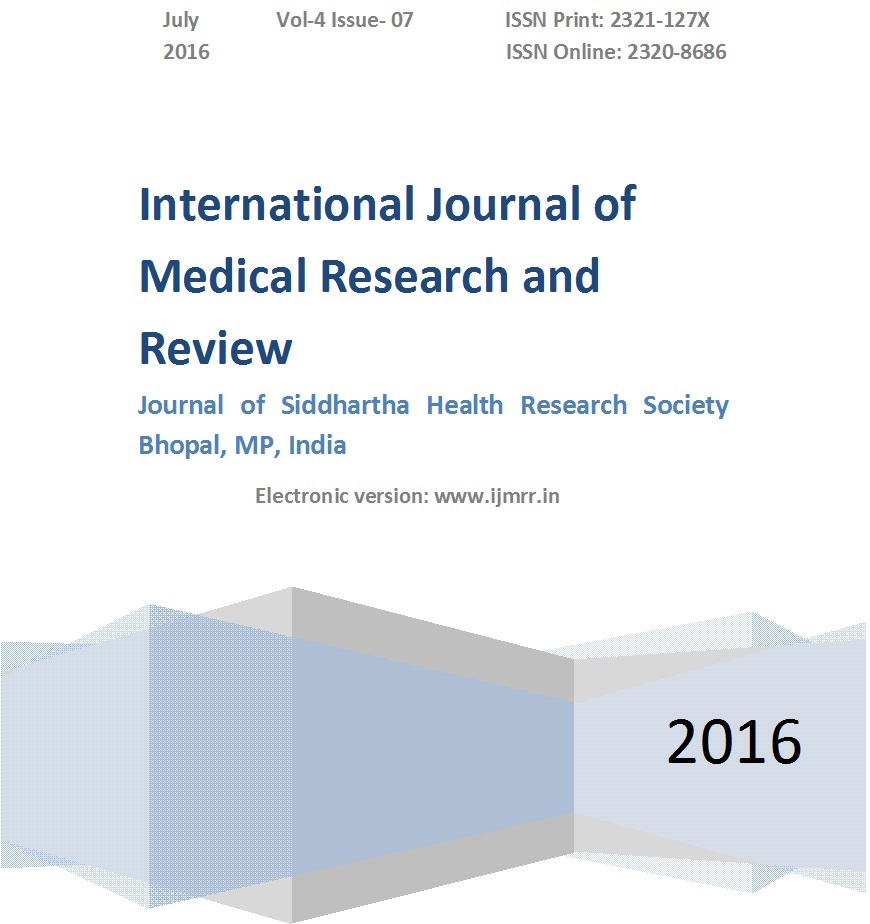Comparative study of manual uterine displacement and wedge under right hip in prevention of supine hypotension syndrome in caesarean section under spinal anesthesia
Abstract
Introduction: Supine hypotension syndrome results in signs of shock, by decrease in maternal blood pressure. This may result in life threatening complications in mother and fetus. To reduce the incidence of supine hypotension syndrome, few practices were recommended by authors in maternal positioning during C-section. Here in this study we are comparing hemodynamic stability between manual uterine displacement and wedge under right hip.
Materials and Methods: 30 parturients were studied by left ward Manual Uterine Displacement (MUD), assigned as Group MUD. Another 30 parturients were studied by placing a 12 cm wedge under right hip (which gives 150 left lateral tilt), assigned as Group Wedge. Hemodynamic stability was assessed in between MUD and Wedge groups.
Results: Systolic blood pressure was lower with wedge under right buttock or hip than Manual Uterine Displacement and it is statistically insignificant. Diastolic Blood pressure fall was almost similar in both the groups. There is a gradual fall in Mean Arterial Pressure in both groups, which is not significant. Heart rate was lower in Wedge Group when compared to MUD group but it was statistically insignificant.
Conclusion: There is no much difference in Hemodynamic changes either by Manual uterine displacement or Wedge under right hip. Surgeons and patients feel more comfortable with Manual uterine displacement than Wedge under right hip, but anesthetists feel better with wedge because there is no need to hold the uterus continuously till delivery of the baby, so anesthesiologist can engage in patient monitoring and treatment.
Downloads
References
Corderoy, Amy (26 Jul 2015). "Failure to cut medical intervention rates in childbirth". The Sydney Morning Herald (Fairfax Media). Retrieved 17 November 2015.
Molina G, Weiser TG, Lipsitz SR, Esquivel MM, Uribe-Leitz T, Azad T, Shah N, Semrau K, Berry WR, Gawande AA, Haynes AB. "Relationship Between Cesarean Delivery Rate and Maternal and Neonatal Mortality". JAMA. 2013 Dec; 314 (21): 2263–70.doi: https://doi.org/10.1001/jama.2015.15553.
Betran AP, Merialdi M, Lauer JA, Bing-Shun W, Thomas J, Van Look P, et al. Rates of caesarean section: analysis of global, regional and national estimates. Paediatric and Perinatal Epidemiology 2007; 21(2):98–113.doi: https://doi.org/10.1111/j.1365-3016.2007.00786.x.
"WHO Statement on Caesarean Section Rates" (PDF).2015. Retrieved 6 May2015.
Cluver C, Novikova N, Hofmeyr GJ, Hall DR. Maternal position during caesarean section for preventing maternal and neonatal complications. This is a reprint of a Cochrane review, prepared and maintained by The Cochrane Collaboration and published in The Cochrane Library. wiley publishers. 2010;6.doi: https://doi.org/10.1002/14651858.cd007623.pub3.
Kiefer R, Ploppa A, Dieterich H. Aortocaval compression syndrome. Anaesthesist. 2003; 52 (11): 1073–83.doi: https://doi.org/10.1007%2Fs00101-003-0596-6.
Banas T, Godula Z, Herman R. Aortocaval compression syndrome as an explanation of sudden intrauterine death of mature twins at term. Case report. Ginekol Pol. 2004; 75 (8): 633–7.
Bronwen Bryant, Kathleen Knights. Pharmacology for Health Professionals. 3rd edition. Elsevier. Mosby Publishers. 2011, pp.273.
Park GE, Hauch MA, Curlin F, Datta S, Bader AM. The effects of varying volumes of crystalloid administration before cesarean delivery on maternal hemodynamics and colloid osmotic pressure. Anesthesia and Analgesia 1996; 83(2): 299–303.doi: https://doi.org/10.1097/00000539-199608000-00017.
Ueyama H, He YL, Tanigami H, Mashimo T, Yoshiya I. Effects of crystalloid and colloid preload on blood Volume in the parturient undergoing spinal anesthesia for elective cesarean section. Anesthesiology. 1999 Dec; 91(6): 1571–6.doi: https://doi.org/10.1097/00000542-199912000-00006.
Kee WD, Khaw KS, Lee BB, Lau TK, Gin T. A dose– response study of prophylactic intravenous ephedrine during spinal anesthesia for cesarean delivery. Anesthesia and Analgesia. 2000 June; 90(6):1390–5.doi: https://doi.org/10.1097/00000539-200006000-00024.
Rout CC, Rocke DA, Levin J, Gouws E, Reddy D. A reevaluation of the role of crystalloid preload in the prevention of hypotension associated with spinal anesthesia for elective cesarean section. Anesthesiology. 1993 Aug; 79(2): 262–9.doi: https://doi.org/10.1097/00000542-199308000-00011.
Colon-Morales MA. A self supporting device for continuous left uterine displacement during cesarean section. Anesthesia and Analgesia. 1970;49:223–4.
Rees SGO, Thurlow JA, Gardner IC, Scrutton MJ, Kinsella SM. Maternal cardiovascular consequences of positioning after spinal anaesthesia for Caesarean section: left 15 degree table tilt vs. left lateral. Anaesthesia 2002 Jan; 57(1):15–20.doi: https://doi.org/10.1046/j.1365-2044.2002.02325.x.
Lees MM, Scott DB, Kerr MG, Taylor SH. The circulatory effects of recumbent postural change in late pregnancy. Clin Sci. 1967 June; 32(3):453-465.
Newman B, Derrington C, Dore C. Cardiac output and the recumbent position in late pregnancy. Anaesthesia 1983 Apr; 38(4):332-335.doi: https://doi.org/10.1111/j.1365-2044.1983.tb10455.x.
Marx GE Aortocaval compression syndrome: its 50-year history. Int J Obstet Anesth 1992; 1:60-64.doi: https://doi.org/10.1016/0959-289X(92)90002-L.
Colon-Morales MA. A self-supporting device for continuous left uterine displacement during cesarean section. Anesth Analg. 1970; 49:223-224.
Crawford JS, Burton M, Davies P. Time and lateral tilt at Caesarean section. Br J Anaesth. 1972 May; 44(5):477-484.doi: https://doi.org/10.1093/bja/44.5.477.
Kinsella SM, Whitwam JG, Spencer JAD. Aortic compression by the uterus: identification with the Finapres digital arterial pressure instrument. British Journal of Obstetrics & Gynaecology 1990; 97 (8) :700–5.doi: https://doi.org/10.1111/j.1471-0528.1990.tb16242.x.
Secher NJ, Arnsbo P, Andersen LH, Thomsen A. Measurements of cardiac stroke volume in various body positions in pregnancy and during Caesarean section: a comparison between thermodilution and impedance cardiography. Scand J Clin Lab Invest. 1979 Oct; 39(6):569-576.doi: https://doi.org/10.3109/00365517909108835.
Milson I, Forsmann L. Factors influencing aortocaval compression in late pregnancy. Am J Obstet Gynecol. 1984 Mar;148(6):764-771.doi: https://doi.org/10.1016/0002-9378(84)90563-5.
Bamber JH, Dresner M. Aortocaval compression in pregnancy : the effect of changing the degree and direction of lateral tilt on maternal cardiac output. Anesth Analg. 2003 July; 97(1):256-258.doi: https://doi.org/10.1213/01.ane.0000067400.79654.30.
Rees GAD, Willis BA. Resuscitation in late pregnancy. Anaesthesia 1988 May;43(5): 347–9.doi: https://doi.org/10.1111/j.1365-2044.1988.tb09009.x.
Kundra P, Khanna S, Habeebullah S, Ravishankar M. Manual displacement of the uterus during caesarean section. Anaesthesia. 2007;62(5):460–5.DOI: https://doi.org/10.1111/j.1365-2044.2007.05025.x.
Eckstein KL, Marx GFF. Aortocaval compression and uterine displacement. Anesthesiology 1974 Jan; 40(1):92-96.doi: https://doi.org/10.1097/00000542-197401000-00025.
Brock-Utne JG, Buley RJR, Downing JW, Cuerden C. Advantages of left over right lateral tilt for caesarean section. South African Medical Journal 1978 Sep;54(12):489–92.



 OAI - Open Archives Initiative
OAI - Open Archives Initiative


